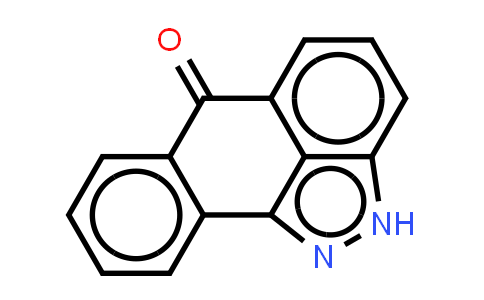| Chemical Name |
SP600125 |
| CAS Number |
129-56-6 |
| MDL Number |
MFCD00022289 |
| Molecular Formula |
C14H8N2O |
| Molecular Weight |
220.23 |
Introduction of 129-56-6 :
SP600125 is an orally active, reversible, and ATP-competitive JNK inhibitor with IC50s of 40, 40 and 90 nM for JNK1, JNK2 and JNK3, respectively. SP600125 is a potent ferroptosis inhibitor. SP600125 inhibits autophagy and activates apoptosis[1][2][3]. IC50 & Target: IC50: 40/40/90 nM (JNK1/2/3)[1] In Vitro: SP600125 is an ATP-competitive inhibitor of JNK2 with a Ki value of 0.19±0.06 μM. SP600125 inhibits the phosphorylation of c-Jun with IC50 of 5 μM to 10 μM in Jurkat T cells. In CD4+ cells, such as Th0 cells isolated from either human cord or peripheral blood, SP600125 blocks cell activation and differentiation and inhibits the expression of inflammatory genes COX-2, IL-2, IL-10, IFN-γ, and TNF-α, with IC50 of 5 μM to 12 μM[1].
In a mouse beta cells MIN6, SP600125 (20 μM) induces the phosphorylation of p38 MAPK and its downstream CREB-dependent promoter activation[2].
In HCT116 cells, SP600125 (20 μM) blocks the G2 phase to mitosis transition and induces endoreplication. This ability of SP600125 is independent of JNK inhibition, but due to its inhibition of CDK1-cyclin B activation upstream of Aurora A and Polo-like kinase 1[3].
In Vivo: Administration of SP600125 at 15 or 30 mg/kg i.v. significantly inhibits TNF-α serum levels, whereas oral administration dose-dependently blocks TNF-α expression with significant inhibition observed at 30 mg/kg per os[1].
SP600125 attenuates LPS-induced ALI in rats in vivo. The expression levels of TNF-α and IL-6 in the BALF in rats in the SP600125 group are significantly decreased[4].
| Purity |
NLT 98% |
| Storage |
at 20ºC 2 years |
*The above information is for reference only.
